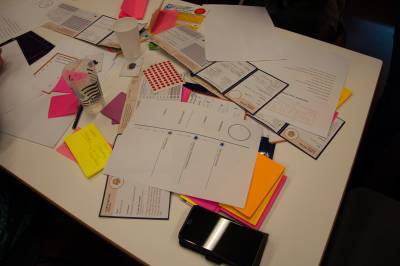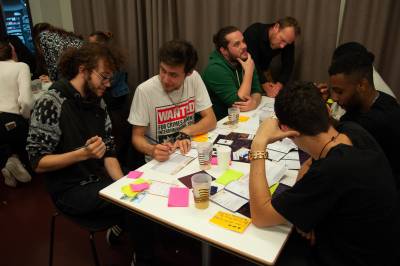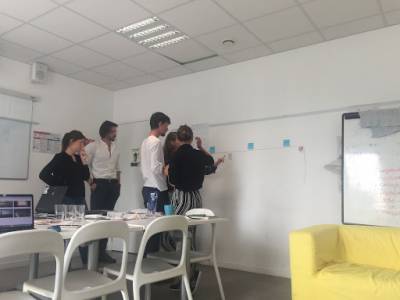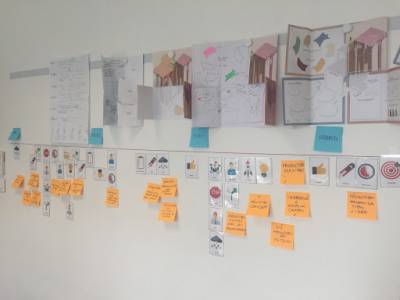Creative tools workshop
Organised by the L'Ecole de design City design Lab over a week, the tools workshop gathered different groups of students to conceive, produce, test and improve two specific AYCH tools to be used at AYCH events with young participants.
The tool creation process was research-driven and iterative. Through the creation process, the students gained a good understanding of the AYCH programme, the participants and the particularities of the events were the tools would be used. An important empathy work was the basis for conceiving or improving the tools. Constant communication with the AYCH partners allowed the students to get critical feedback as they tested the different versions of the tools.
As two groups of students worked on the creation of their respective tool, a third group of students observed the creative process and facilitated, at the end of the week, a feedback session for which they put in place a management communication tool. Thanks to the observation process and the final feedback session, the tool creators had the opportunity to analyse their creative process and have a critical stand on the challenges and opportunities of it.
Stranger Job
Stranger Job is a speculative design tool created by the City design lab students Benjamin Garnier, Louise Bragard, Jules Riché, Marguerite Gueret and Maurine Guingamp. The tool, in the form of a serious game, aims at fostering participant's creativity by setting the game into a near-future. The participants are then free to imagine the future as they would like it or not to be. They will then have to create the job(s) of the future.
The creative process
Stranger Job is inspired by the first speculative design game developed by AYCH: AYCH Future cities. The driving principle for the creation process of the tool is simple and powerful: set the participants in the near future and push them to think differently as a group. In this sense, the different steps of the game should challenge and guide the participants through the definition of that alternative future and accordingly, imagine a pertinent job.
Creating a tool for fostering collective intelligence requires collective intelligence. Collaboration with the Brest partners was a key element of the tool creation process. Constant exchanges of ideas through a sharing platform nourished the first versions of the tool and allowed the designers to come up with particular activities that were relevant for the purpose and the participant's profile. Different prototypes of the game were tested by partners and other young users that had no knowledge of the game.
Another key element of the game is that it is context-specific. Although it sets the participants in a fictional future, the future happens in a really precise place: Brest. All the exchanges and reflections were bounded to the knowledge the participants have of the city as it is today. The game, aimed at integrating that knowledge and challenge it in order to propose alternatives ways of doing, functioning and ultimately working in Brest in 2045. Once again, the exchanges with the Brest partners prooved to be crucial in finalising the different elements of the game so it had a good balance between prospectiveness and context-specific elements.
Feedback from the field
The tool was tested during a 2 hours workshop in Brest with a total of 30? participants that played in groups of 6. For each group, there was one of the creators of the game and another organiser that acted as facilitators. This allowed not only to guide each group in the process, keep the levels of energy and clarify any doubt but also to observe the different forms of interactions that took place during the game.
The general feedback from the participants and facilitators was positive. The introductory video was very effective in projecting all the participants in the future thanks to its powerful images. It also encouraged the participants to keep up with the challenge while keeping a positive attitude and energy.
The direct observation was also key in identifying opportunities for improving the game. In the first place, the identification of the problem to be solved within each group was a difficult task in most of the groups. It would be interesting to ease the transition between the “stakes” and the specific problems the participants could formulate. Secondly, during the experience, one group managed to go a step further at the end of the game and instead of just identifying 3 different jobs the group proposed to create a whole new company with potentially a completely innovative business model. A longer version of the game could guide the participants through the conception of a company.
A journey to your project
A journey to your project, created by Marine Bauduin, Antoine Laurent and Chloé Verron; is a creative tool conceived to be used in one workshop of the Exmouth Creative Jam that took place in October 2019. The tool aims at helping a group of young participants to identify and quickly develop an idea that they will prototype later on. The tool takes the shape of a simple folding paper sheet that proposes different steps to go through collectively. The tool provides with a frame to follow a design thinking approach to help the participants to prototype more efficiently and easily.
The creative process
During the creative process, exchanges with the Exmouth organisers prooved to be essential. At the beginning of the process, the needs of the partner, the aim of the workshop and the time allocated to using the tool weren't completely clear. In this sense, the group of students first created a version of the tool that was meant to be used individually. The aim was for each participant to develop their own idea and at the end of the session, the group would have to choose one idea to be prototyped during the whole creative jam. After a key feedback session with the partners, the tool went through some important adjustments. Rather than being an individual tool, the new version draws on the collective intelligence of the participants to develop one single idea and more focus was put into identifying the best prototyping technique for that idea.
In the image, we can see the evolution of the creative process, the difficulties the group encounter through it and the different forms the tool took as the creative process went on. Despite the distance with the partners, the production of working prototypes was key in getting feedback from the partner and for improving the tool.
Feedback from the field
The tool was used at a 1-hour workshop during the Exmough Creative Jam. A total of 15 participants between 15 and 18 years old worked in smaller groups. Each group of participants was accompanied by a facilitator who had participated in the creation of the tool and other young workers.
In general, A journey to your project smoothed the transition between the identification of an idea into the prototyping of a concept. Additionally, it worked well as a synthesis tool in which the groups could crystalise and keep track of the key elements of their ideas. The questions asked through the tool allowed the participants to be more precise around the functioning of their project.
The visual identity of the tool worked well. The purpose of the tool was well understood and the tool brought color and dynamism to group tables. However, it would be interesting to adapt the format of the tool to the importance of the different steps proposed. For instance a smaller first part and a bigger space for answering the big questions: Who, When, Where.
Counting with the support of a facilitator with experience on youth collective intelligence work and a good knowledge of the specific context of Exmouth was key in helping the groups of participants to make progress in the creative process.







